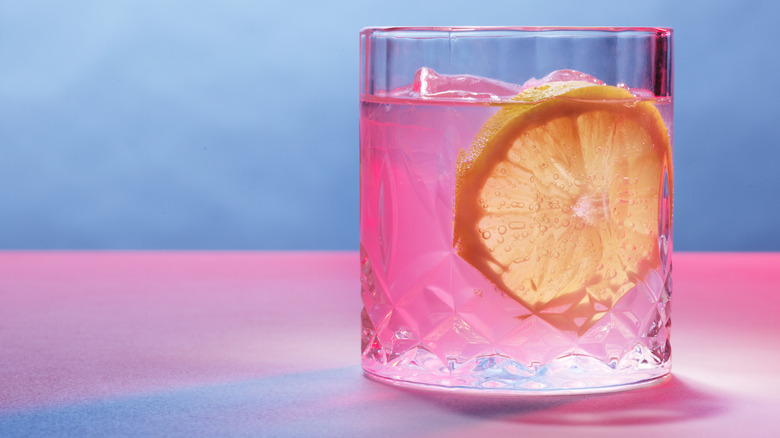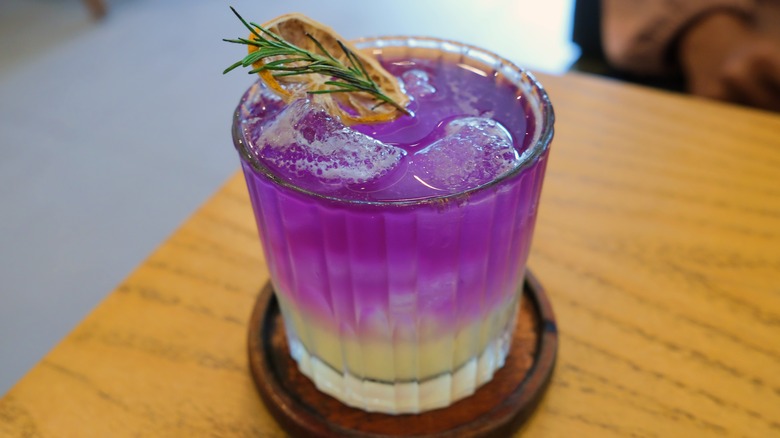Zero-Proof Drinks Vs Mocktails: Is There A Difference?
Non-alcoholic cocktails are having a moment in America. Spirit-free aperitifs have even entered the canned RTD beverage category. But if you've been using the terms "mocktail" and "zero-proof cocktail" interchangeably, allow us to set the record straight.
Both categories can be made with alcohol-free spirits: potent tinctures of highly concentrated flavor that functions like a base spirit for building a cocktail. The popular brand Ritual, for instance, makes a line of zero-proof dupes for backbar staples like rum, whiskey, gin, tequila, and Aperol. Some avant-garde offerings like Seedlip have branched beyond piety into the classic liquor lineup with experimental zero-proof spirits that don't taste like any existing liquor. The brand's conceptual trio of Garden 108, Grove 42, and Spice 94 have received high marks from industry professionals. Ingredients like these make it easy for bartenders to craft alcohol-free cocktails with mature dimensionality.
Now, on to distinguishing the difference. Zero-proof drinks, as the name explicitly states, contain no alcohol content whatsoever. Technically, a drink can contain up to 0.5% ABV and still be legally considered non-alcoholic. The key difference between this category and the mocktail category is all about creativity. As indicated by the mimic-centric title, "mocktails" are non-alcoholic versions of traditional cocktails — i.e. drinks that already exist and are well-known. A "phony negroni" mocktail still tastes like a classic negroni with flavor notes of gin (substituted with a non-alc gin alternative, like s DHŌS Gin-Free), sweet vermouth (Lyres Apéritif Rosso), and bitter orange Campari aperitivo (Sanbittèr).
Mocktails mimic existing cocktails, while zero-proof drinks are free to branch out into new flavor combinations
A good, fidelous mocktail captures the existing aromatic profile of cocktails that fans know, love, and expect from their favorite spirited drinks. Mocktails don't necessarily have to include dupe base spirits either. A virgin piña colada is technically a mocktail, and it's made from just pineapple juice, cream of coconut, and ice. A bloody mary without vodka would also be considered a mocktail.
Zero-proof drinks, on the other hand, are their own thing entirely. A zero-proof drink loaded with rosemary, lavender, and a spiced herbal tincture "base spirit" doesn't closely resemble any existing drink in the traditional cocktail oeuvre, and it doesn't have to. In fact, by this definition, non-alcoholic classics like the Shirley Temple, Roy Rogers, and Arnold Palmer are zero-proof cocktails, not mocktails.
Modern iterations of zero-proof cocktails tend to employ liberal garnishes from fresh botanicals to exotic fruits, served in ornate glassware for zhuzhed-up presentation. Zero-proof drinks mark a new craft beverage sector with its own ingredients, tasting notes, and innovative creations, assembled following the basic rules and techniques of traditional bartending like flavor layering, sweetness balancing, and attention to texture.
Zero-proof creations like chili-lime-pineapple spritzers and rosewater-lemon fizzes are emblematic of a larger shift in the collective social mind regarding alcohol. Now, thanks to the advent of the mocktail and the zero-proof cocktail (which are not the same thing, after all), folks can still enjoy a sophisticated mixed drink sans alcohol.

